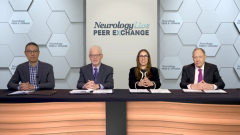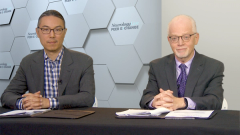
The Unmet Needs in NMOSD
Drs Brian Weinshenker, Flavia Nelson, Robert Shin, and Aaron Miller review the unmet needs in the treatment of NMOSD as well as hopes for the future.
Episodes in this series

Brian Weinshenker, MD: Let’s turn to the final segment of our program, which is going to be forward-looking. We’re going to look ahead at future directions for NMOSD [neuromyelitis optica spectrum disorder]. Dr Miller, I’m going to start with you and ask you, what are the unmet needs both in research and clinical development for NMOSD patients, and what clinical trial end points would you like to see addressed?
Aaron Miller, MD, FAAN: Well, I could give you a fairly long wish list, but some of them are doable, and maybe some are not currently doable. For one thing, I’d like to see us develop a better therapy for seronegative patients. Despite the remarkable success of each of these agents in their clinical trials, those that included seronegative patients, seronegative patients performed much less well than the seropositive patients. So having good therapy for that group would be helpful. We’ve talked a lot today about how we choose among these agents. So, if we had biomarkers, for example, that could predict the success of a particular agent or help steer us to a particular agent, that would be great. That’s probably a far-out wish because I don’t think we have anything on the immediate horizon for that.
In terms of clinical trial data, Bob did talk about the relatively long-term data that we have, but it’s still really short long-term data that only goes out a few years, which is a short time in the course of a lifetime disease. So, I take lessons from the story with the anti-CD20 agents in looking, for example, at the Scandinavian study that shows over years of use of these drugs that they’re associated with more severe infections than some of the other drugs we use in MS [multiple sclerosis]. So, I think we need longer-term safety data. You yourself mentioned the issue of potential immunoglobulin deficiency with inebilizumab, and that we haven’t seen that yet, but we have only a few years of data, and so we need more long-term safety data. We also could benefit from some more data about the severity of the relapses. If those patients are having relapses, is the recovery different from one drug to the other?
Brian Weinshenker, MD: I think that’s an excellent point and not really preplanned, but post hoc. There seems to be some evidence from eculizumab and also in inebilizumab that attacks were not only less frequent, but the attacks that occurred were less severe. Bob, I’m going to turn to you in regard to what Aaron said about how it would be nice to have clinical trials, perhaps with some biomarker measure, that might make it feasible to do better head-to-head comparisons because, with the effectiveness of these drugs, it seems very difficult to design clinical trials as we have been doing and have the power to address their relative efficacy. Could you tell us a bit about what end points might be promising for the future?
Robert Shin, MD, FAAN: Since we’re speculating or maybe we’re generating a wish list, one thing I would say that’s maybe different in the NMOSD space from the MS spaces, I’m not as sure MRI is as useful in NMO, which is interesting in MS. I think regular MRIs are important because you can often have subclinical disease activity. And we wouldn’t pick that up without an MRI, or hopefully we’ll have other measures on more advanced MRI techniques that’ll give us insight into that disease process. Interestingly to me, and I think we agree, typically in NMO [neuromyelitis optica] spectrum disorder, it’s the clinical relapses that are the problem. And I think it’s unlikely that you would have subclinical MRI activities. So, our focus is really going to be clinical.
But in terms of biomarkers that Dr Miller was talking about which, again, we’re looking at in a number of different spaces, I think we’d be looking for something that will be predictive. So, for instance, we already know that there are markers of either neuronal or astrocyte injury; as you said, this is really an astrocyte such as in this case, GFAP [glial fibrillary acidic protein] levels are elevated in patients with NMOSD relapses. And as we were discussing offline a little bit there is some evidence that if you’d look at a group of individuals, a group with higher levels of GFAP are more likely to subsequently have relapses.
I think what’s going to be challenging is for us to figure out for an individual person with NMOSD will a marker like serum GFAP be useful to help us predict those in whom the medication perhaps isn’t as effective as they would like it to be or be able to essentially predict disease activity. As Dr Miller said, I think we’re a little bit away from that.
Brian Weinshenker, MD: And just to expand on GFAP, originally, this was studied in spinal fluid and found to be dramatically elevated, but it’s only relatively recently with the single-molecule analysis Simoa technique that we can measure this in blood. And this was applied in the inebilizumab study. And there are data that have come out of that study that show GFAP levels are lowered by being on treatment within inebilizumab.
Flavia Nelson, MD: What about neurofilament light chain biomarker testing? Would that be on your wish list?
Robert Shin, MD, FAAN: Well, there is also some data that tells us that those levels are elevated as well. Because as we said at the beginning, it’s an astrocytopathy, but neuronal injury occurs as a secondary bystander effect. If we understand the pathophysiology correctly, I think I would argue GFAP would be a more direct measure of the pathology, but it has been shown that that leaks as well from the CSF [cerebrospinal fluid] into the serum, and that can be detected as well.
Transcript edited for clarity
Newsletter
Keep your finger on the pulse of neurology—subscribe to NeurologyLive for expert interviews, new data, and breakthrough treatment updates.


































